


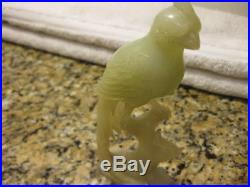
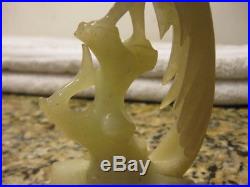
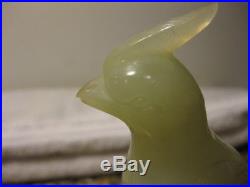
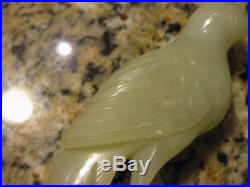
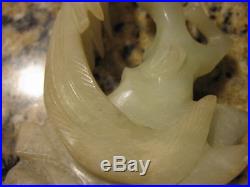
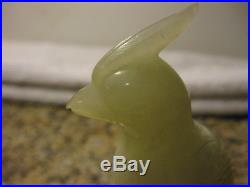
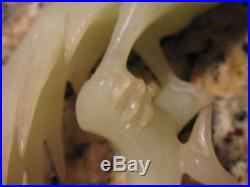
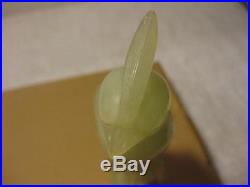
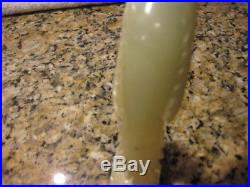

CHINESE JADE HAND CARVED BIRD EXQUISITE hand-carved vintage Chinese Jade bird. One of the feathers has been chipped off. Please see photograph for more detail. OTHER THAN THE ONE CHIP, this bird art is in good vintage condition. This delightful sculpture is 8″ tall by 2″ will by 4 deep. It will bring years of joy to your home or office. ANY REASONABLE OFFER IS WELCOMED! ALL ABOUT JADE Inclusions: The natural jadeite pattern you can see within natural Jadeite which may look like streaks, spots, or cracks is naturally formed millions of years ago. Commercial jadeite B, C, & D Grade is bleached to remove inclusions that are not wanted, like black spots. A Grade Jadeite is natural, and untreated. Chime: Jadeite chimes like a bell when struck with anything metal. The finer the grainthe higher frequency of the chime. Real, untreated, natural jadeite has very fine grain and a very high chime. The higher the pitch of the Chime is one of the tests to determine the quality of jadeite. Also see “stone lines” below. Stone lines: Geological pressure during the jadeite evolution causes the structure of the jadeite to be different throughout. You can see this in all jadeite under 10x magnification, and you can often see it without any magnification. It looks similar to cracks in ice and it might look like a crack, but is not a crack. It is called a healed crack that is naturally formed. “Fine grained” jadeite has fewer of these natural lines, and the “chime” is higher pitched depending on the grade of jadeite. Grains: Inter-granular cracks in the fibrous structure of natural untreated genuine jade or jadeite. Is not cracked or damaged, it is the way it was formed from mother earth, a natural occurrence in jade. Green Jade- is the most common color of jade. It is thought to be calming to the nervous system. Green jade is thought to represent life and growth and to assist one in finding their heart true desire. It is associated with the heart chakra and is thought to make it easier for the wearer to express love. White or Cream Jade- is used to direct ones energy and assist in concentration, by filtering out unwanted distractions. White and cream jade has long been used to boost energy and to ascertain what the highest outcome for a given situation will be. Lavender Jade- is said to bring one in touch with their emotions, especially the softer side. It is said to assist in honest communication and self control. It is often given as a gift to someone who has been hurt or disappointed by love. JADE’S HEALING ATTRIBUTES Jade Symbolizes purity and serenity, attracts good luck and promotes self-sufficiency. Helps release negative thoughts and awakens inner knowledge. Said to encourage compassion and humility and to promote longevity. Associated with the kidneys, and used for detoxifying. Assists fertility and childbirth. HERE ARE SOME INTERNET-BASED SOURCES AND WHAT THEY HAVE TO SAY ABOUT JADE Chakra: Third Eye, Soma Zodiac Sign: Aries, Taurus, Gemini, Libra (Jadeite Aries, Nephrite Libra) Planet: Venus Used for serenity, wisdom, balance, all things associated with the best of spiritual practices. This gem stone is the ultimate symbol of calm and serenity. It helps bring serenity to the mind by releasing negative thoughts. A stone of balance and healing, it alleviates anxiety and fear based emotions. Vibrates in harmony with the Heart Chakra unlike any other stone. Opens up the heart Chakra to love energy. Spirituality: Jade is said to encourage self-realization and help us to recognize ourselves as spiritual beings. Longevity: Believed to bring the holder a long and fruitful life. Luck: Know as a good luck and prosperity charm for centuries. Detachment: Helps you to be calm and accept your surroundings for what they are, instilling a sense of detachment to the chaos, and not claiming it for your own. Discernment: Jade helps the wearer to sense the truth in all situations. Dreams: Helps one with remember their dreams, and provide help with dream-solving. Aids dream recall if placed under pillow. Desires: Also helps you in bringing your dreams into reality, and in making all things possible. Love Stone: Jade is given by lovers as a statement of their love and devotion to each other. Humanitarian: Jade helps you to tune into the needs of others, rising above yourself, and gives your insight into their problems. Priorities: Helps you to put things in the proper perspective, and focus on the primary concerns for today. Confidence: Jade assists in self-assurance, self-reliance, and self-sufficiency. Jade has long been a sacred stone. It was often included with Chinese grave goods to give vitality to the deceased. It was also often used for weather magic to call up snow, mist and rain. A protector against danger for children, Jade can undo physical harm. It is also a symbol of purity, serenity, and nurturing and is a dream stone. Placed on the soma chakra it can bring insightful dreams. Jade symbolizes the personality and helps to integrate mind and body. Jade encourages you to become who you really are, recognizing yourself as a spiritual being on a human journey. Jade is the prince of peace and tranquility. It acts quietly as a consciousness raiser of human development. Jade dispels negativity by the constant emission of soothing and cleaning vibrations. Jade symbolizes the Confucian virtues of wisdom, compassion, modesty, justice and courage as well as the female erotic. The mysteries of Jade are ancient and to this day jade still persists to mystify admirers with its unique qualities as the Stone of Heaven. Jade is believed to bring its wearer good health, good luck and protection. For this reason Jade is considered priceless as it stands for the essence of purity and the symbol of life. Jade also helps to calm one down. It helps you to accept things that are difficult in your life and makes things appear to go much smoother than they really are. It keeps you from disconnecting from your inner peace. Jade is a stone that helps you to realize the needs of others. It is also good for helping you to understand what is of prime importance for you to do on this day. It brings confidence and self-assurance, self-sufficiency and to be self-reliant. Jade also gives purity and serenity, attracts good luck and promotes self sufficiency. JADE FACTS: Jade derives its name from the Spanish piedra de hijada, meaning stone of the loins, so called because of the belief that it could cure ailments pertaining to the loins, or kidneys. It has been held in high esteem by the Chinese since ancient times and was carved into beautiful love tokens and talismans and believed to promote longevity. The earliest decorative artifacts found include simple discs or buttons but jade was also used in prehistoric knives and weaponry. Most commonly occurring in shades of green, nephrite jade can also be creamy white mutton fat jade. HEALING ATTRIBUTES Jade Symbolises purity and serenity, attracts good luck and promotes self sufficiency. JADE Jade is the 12th, 30th and 35th Wedding Anniversary Gemstone. In the West, Jade is considered to be nature’s tranquilizer, a stone which helps us to be more claim and relaxed. Opens intuitive and psychic abilities. In Chinese, Feng Shui believed jade to have the power to bring you good luck, ward off evil spirits and keep demons away. Jade and the land of China Jade has been adored and revered by the Chinese people since time ancient. From the down of civilization, in spite of the formidable that have fallen upon the Chinese, bothsentiment toward jade and the tradition of jade artistry haveendured the passage of time and remained undiminished in strength. NEPHRITE & JADEITE Nephrite Chemically speaking a silicate of calcium and magnesium, nephrite belongs to the amphibole group of minerals. Throughout the ages, nephrites has been frequently employed as a working material. Nephritie appears in numerous colors, snowy white, bluish white, yellowish hue, brown, gray, black, green, dark green. Commonly use in jade carving art. Jadeite A silicate of sodium and aluminum, jadeite is classed as a pyroxene. Although in class different from nephrite, jadeite shares many characteristics with it, namely a high degree of hardness and firmness, and a luster that lends an appearance of transparency. Additionally, variations is iron content result in brownish-red, dark green, or lavender hues. Presence of minute amounts of chromium yields emerald green. Commonly use in jewelry. A B C JADE A, B, C Jade Type or grade A , B, C , commonly use by jade dealers to identify the different type of treatment of the jade. Not refer the quality grading of the jade. Type A or Grade A Natural Jade without treatment. Type B or Grade B Natural Jade treated with polymer. Type C or Grade C Natural Jade treated with enhanced color. Care of Jade Stone Use mild soap and warm water is the easiest and safest cleaning solution. Use soft towel to dry. Better to take if off when you are cooking or cleaning. Avoid chemical cleaners at all costs. JADE The Eternal Jewel. Chinese women ask for jade ornaments for their hair, and old men keep in their hand a piece of cool jade, so smooth that it seems soft to touch. The poorest courtesan has her bit of jade. Because jade is the most sumptuous jewel against a womans flesh. Buck My Several Worlds JADE The Jewel of Heaven Jade has been accepted by the Chinese as the bridge between man as he is and man as he ought to be. It was the link that connected Heaven and Earth, the bridge from life to immortality. Many of the carving styles derived theirinspiration from the special place in the Heavens accorded this mysterious stone: the perforated disk (or pi) was meant to be a device through which men spoke to the gods: the six ritual colors (green, blue, lavender, red, yellow, white and black) were cut and carved in specific ways by the Imperial Court of China to convey obeisance to Heaven. Jade was even entombed with the owner to prevent decomposition. Almost every object or force in nature is found in the symbolism that surrounds jade. Trees, flowers, vegetables, mountains, rivers, oceans, insects, thunder, lightening, rain, the moon, sun and stars, and all types of animals (both real and imaginary) all had their place and meaning. In ancient China, as in modern China, virtually all important occasions in life are celebrated by the giving of a piece of jade: births, marriages and business agreements are a few examples. There is a class of thin, sequin-like carvings often referred to as baby jade after the custom of sewing them onto baby clothes to bolster an infants health trough his first year. It is considered good luck to own jade and even better luck to receive it. Many Chinese even today believe that the longer one owns a piece of jade, the finer it becomes in texture and color. JADE What Is It? Jade is the collective term for two substances: Nephrite (a silicate of magnesium) and Jadeite (a silicate of aluminum). Nephrite, the older of the two, is known to date as far back as Chinese recorded history, at least 5,000 years ago. It is inseparably linked with Chinese worship, court ceremonials, Chinese thought and art. Its toughness accounts for the fact that it first appeared as farming implements, knives and bowls. It was also known and used by the pre-Colombians, the Aztecs and the New Zealand Maoris. Even Aladdin, before he found his lamp, marveled at the jade trees in the caverns. Nephrite was mined in China until about the Han dynasty (306 BC 220 AD) when Chinese supply dwindled, and thereafter from the region near Turkestan. Jadeite is a comparatively modern stone, being carved to any great extent only since about 1750. It came to China from Siam, which is still the only important source for Jadeite. Gem quality jade today is actually Jadeite. It is renowned for its brilliant green color; its value today far surpasses that of nephrite, whose worth primarily derives from its antiquity. Both stones are extremely hard and durable. Jadeite accepts a very bright and lustrous polish because of its micro crystalline structure, while nephrite usually has a waxy texture. Most modern authorities rarely bother to distinguish the two substances and they are both simply regarded as Jade. JADE The Most Difficult Stone Because of its toughness, jade is extremely difficult to carve: as the ancients said, it was worked with its own dust. Legend has it that men spent a lifetime creating the perfect carving that best used the material and wasted least. The Imperial Court, which forbid the general public from owning jade, employed its own staff of artists. It is said that the Empress Dowager owned 5,000 ebony boxes filled with jade jewelry. The very toughness of jade makes it ideally suited for fine, intricate carving. Its durability insured the fact that many generations in the same family could own and admire the exact same piece of stone. This is why jade must not be considered as an ordinary gemstone. During the Boxer Rebellion, with the new foreign interest in jade, carving took on a more decorative and fine characteristic, and continued the tradition of Chien Lung motifs. Modern jade carving is conducted primarily in Hong Kong with Peking-trained carvers and their students. The greatest threat today to the continuation of the long tradition is not the lack of manpower, but the scarcity of suitable material. JADE How Much Should It Cost? How much to pay for a piece of jade jewelry? This is a question every consumer must ponder. There are antique pieces that are literally priceless; in its finer qualities, jade can be the most expensive jewel in the world today. One Chinese emperor offered fifteen cities for a piece of jade carving he could hold in one hand. As an investment, jade has had a long record of sound and ever-increasing value. It has survived depressions and fluctuating markets to increase in value in the past and will continue to do so in the future. One Chinese proverb says (in part): sell all else but keep jade. Keep in mind that while all jade appreciates, the finer pieces always appreciate the most rapidly. Of the six basic colors of jade, green is the traditional color, and the most expensive. Rapidly gaining popularity are red and lavender, and their respective prices are also on the rise. There are at least 100 recognizable shades of green: Celadon green, apple green, leaf green, Imperial green, etc. Imperial jade is a term much misused today. It originally referred to jade in the Imperial coffers, but now denotes a stone that is a bright deep, lustrous, clear green. What nature has given to the world is not unlimited in quantity. As world interest in jade grows, the supply of fine material diminishes and few new mines have openedin the last few decades. Much of todays jade is re-cut from older pieces. It is inevitable that the law of supply and demand shall drive prices higher and higher. Jade is virtually unique in that it is traded by the piece. One must appraise a piece according to how pleasing one finds it: how fine the color, clarity, carving style, texture. Size is important, but not the only consideration. Far more important is how much one likes it. Jade, as with most other gems, has its imitations. Most frequently encountered are serpentine and soapstone which are passed off as nephrite. Jadeite imitations include dyed marble, green glass (Peking Glass), grossularite garnet, plastic, chrysophrase (a natural Australian stone of much less value than genuine jade), and pale natural jade stones that have been color-enhanced by dyeing. Dyed jade often fades quickly and can sometimes be spotted by noticing stronger coloration in the natural inclusions that characterize the real thing. Always be suspicious of unusually low prices. The importance of choosing a qualified and reputable jeweler cannot be overstated. He is in a position to obtain the best pieces from the best sources. What is jade and jadeite? Over 100 million years ago, when the magma gushed from the earth crust and became cool some minerals experienced complicated chemical reactions thus jade stone came into being. The true jade namely nephrite, consists of silicates of calcium and magnesium; it varies in colors according to the proportion of iron contained. Jadeite is harder and consists of silicates of alumina and sodium, which is regarded as an excellent substitute for jade. In China about one hundred and seventy different kinds of valuable stones are frequently included in the term jade. What is the Difference between nephrite(jade) and jadeite? Physical and chemical characteristics Nephrite Jadeite Chemical composition Ca2(Mg, Fe)5Si6O22(OH) NaAISi2O6 Mineral composition Amphibole Group Pyroxene Group Crystalline structure fibrous micro-granular Hardness 6-6.5 6.5-7 Specific gravity 2.9-3.1 3.33 Refractive index 1.62 1.65-1.66 Polished surfaces Smooth with a waxy sheen Hard and lustrous Color Evenly distributed; translucent white, dark green, black Spotty or clustered distribution; white, grey, green Chinese jade culture. The jade culture of China is very deep and rich. On the sites of Hongshan Culture and Hemudu Culture archaeologists have found jade objects, which can date back to the early Neolithic period (around 7,000years ago). At that time ancient Chinese used jade stones as tools and ornaments. Ancient Chinese in the Xia, Shang, Zhou dynasties (21st century BC to 8th century BC) used round flat piece of jade with a hole in the middle, which was called yu bi to worship the heaven and used long hollow piece jade with rectangular sides, which was called yu cong to worship the earth. So jade was very important ritual implement in ancient China. Ancient Chinese revered jade and they believed jade was the talisman and it had miraculous power to keep evil spirits away and protected the wearer. The ancient nobles and royalties possessed jade ornaments and jade ware to show their power, social status and wealth. Jade articles were even buried in the coffin as they believed that jade could keep the dead body from being decayed. The famous jade clothing sewn with gold thread was discovered from one ancient tomb of the Western Han Dynasty(202BC-8AD) in 1968. It was made of 2,498 jade pieces and 1,100 grams of gold thread. It is the funerary dress for the Emperors and high ranking nobles in the Han Dynasty. Chinese people even endowed jade with a lot of cultural connotations. According to the quality of jade people compared their virtue with jade. Jade is warm, smooth, lenitive with luster, which is like the virtue of benevolence. Jade is translucent and its flaws can be seen, which is like the virtue of honesty and loyalty. Jade can be broken yet can not be bent, which is the virtue of braveness. Jade can send good and clear sound when being struck, which is like the virtue of wisdom. It is sharp when cut but does not injure people, which is like the virtue of righteousness. In ancient time gentlemen with good virtues wore jade and would not take jade off without special reasons. Actually the virtues of jade tally with the traditional Confucian norms, which were widely advocated by ancient Chinese. Jade in Chinese is pronounced yu and it stands for beauty, purity and good virtue. So it is always related to other words and idioms. Jade will not become ware without being carved and polished that indicates man will not become a useful person without being cultivated. To be like jade and flower means the girl is so beautiful and charming. Gold and jade words means the Emperors words. Keep the body as jade means to keep ones reputation pure. The God in Chinese Taoism is called Heavenly Jade Emperor. The Chinese character of jade (yu) is always used in names. One of the Four Beauties in Chinese history, named Yang Yuhuan, the beloved concubine of Emperor Xuanzong in the Tang Dynasty (618AD 907AD). Yang is her surname and her given name is Yuhuan, which means jade ring. Altogether there are hundreds of Chinese characters containing the radical (the basic structural part of a Chinese character) of jade. Jade is really very important in Chinese culture. The value of jade and jadeite. Jade is rare with beautiful natural colors and it is difficult to find and to mine. Jade is hard and is difficult to process. That is why jade is regarded as gemstone with diamond, ruby, sapphire and emerald. All over the world there are very few places producing jade. Jade stones are formed over long geographical epoch. In ancient time Chinese people went to the mountains or riverbed to try their luck to look for jade. After thousands of years exploitation, high quality jade stones become almost depleted. Jade is hard, especially jadeite with the hardness of degree 6 or above. (on the basis of the hardness of diamond is 10) Today man-made diamonds can be very close to the quality of natural ones. However, jade stones can not be man-made like natural ones. There is a proverb in China There is price for gold but there is no price for jade. The health protection function of jade. Jade is used in the practice of Traditional Chinese Medicine. Commonly, it is ground into fine powders with other ingredients. According to practitioners, jade has the function of calming the soul, maintaining healthy blood circulation, and clearing the eyes and ears. It can moisten the heart and lungs. Moisten, here refers to a positive maintenance of the liquid medium that protects and lubricates body tissue. The ancient Chinese took jade powers to prevent and cure disease. It has been a major medical ingredient for treatment and as prevention for aging. Chinese people believe that jade can ward off evil spirits and bring good luck. It is the talisman of human body. Modern science and technology indicate that the jade contains the zinc, magnesium, copper, selenium, chrome, manganese, cobalt… These micro elements are good to human body. Usually wearing jade, human body skin can absorb micro elements from the jade. Jade can also absorb toxin from human body. Jade can coordinate the balance of inner organs of human body. When wear jade it can massage a certain acupuncture points to stimulate the blood circulation system. Jade can store Energy Qi and keep Yin and Yang in balance. Jade can absorb sunlight in daytime and can release it at night. The producing area of jade in China. The four most famous jade stones in China are Hetian jade in Xinjiang Uigur Autonomous Reign, Dushan jade in Nanyang, Henan Province, Xiuyan Jade in xiuyan city, Liaoning Province, turquoise in Yunxian, Hubei Province. The quality of jade. The quality criteria of jade lies in many aspects, such as the brightness of color and luster, compactness of inner structure, workmanship of the carving and so on. For example, nephrite creates an oily luster and jadeite creates a vitreous luster. Tiny cracks can lower the value of jade; on real jade, air bubbles can not be seen; the more lenitive jade has the higher quality it has. The value of Jadeite and how does the treatment affects its value? Jadeite is proved to be more profitable in these years. The price of jadeite rises about 100% to 50% per year. But only those all natural jadeite can be looked as estate, which is called Grade A jadeite. If the jadeite is treated, it can only act as an ordinary accessory or ordinary product, no longer a precious stone, because its texture is damaged and durability is greatly decreased. After it has been worn for a certain period of time, irregular tension micro-cracks will appear. It is the reason why the price of all natural jadeite is far higher than treated ones, which is the difference between precious stone and ordinary accessory. There is now a new lexicon in the jade world: “A” jade indicates natural jadeite jade without color enhancement. “B” jade indicates bleached, polymer-impregnated jadeite jade. “C” jade indicates color-enhanced jadeite jade (either bleached or not). What are A Grade jadeite, B Grade type, C Grade and so on? Grade A jadeite: all natural jadeite, without any treatment. This type of jadeite can be bought as a real precious stone or investment. Grade A jadeite is more translucent with natural vitreous luster. It can send clear and metal like sound when being knocked. Grade B type jadeite : the natural jadeite is soaked in a mixed strong acid solution. Next, soak it in epoxy resin mixed with hardener. Then take it out and heat it to harden it. This kind of treatment can improve the color and transparency of the jade. But its texture is damaged and durability is greatly decreased. It can send dull sound when being knocked. Be aware that Grade B type jadeite can also be called “natural color jadeite “, because it is not dyed, its color is really natural. Grade C jadeite: colored or dyed jadeite. Grade B+ Grade C jadeite: the jade is dyed after acid-treated and resin-filled, which results in beautiful color and great transparency. But the color is not natural and the durability is greatly decreased. Grade D jadeite: this kind is not real jadeite It is another kind of jade or stone but looks like jadeite. It pretends to be jadeite because jadeite is he most precious and expensive one in the jade-like minerals. Identification of Grade A, Grade B type, Grade C, and Grade B+C jadeite. Some experienced craftsmen and traders can examine jadeite with naked eyes, by its color and luster or by its sound. To consumers, the best way to judge a piece of jadeite is to ask for a gemologist identification certificate by a testing center. How to take care of jade and jadeite? People believe jade has life and soul and it needs constant care by collectors. Firstly, avoid being bumped on hard surfaces as jade is delicate. Although sometimes a crack can not be seen by the naked eye, the interior structure may have been damaged. As time goes on, it will appear and reduce its value. Secondly, protect jade articles from dust or greasy dirt. If blemished, they must be scrubbed with a soft cloth or washed with clean water. Thirdly, when left unused it is best to store the jade in a case or box to protect it from being bumped. Fourthly, jade should be kept away from perfume or chemicals otherwise it will tarnish. Fifthly, do not expose jade to sunlight for a long time, otherwise it may expand and the quality will change slightly. Finally, jade has certain water content so do not keep it in a dry area. The history of jade carving in China. Jade carving appeared in China in the Neolithic Period and it became a separated profession in the Shang and Zhou dynasties about 3,000 years ago. The excavations have shown the fine workmanship of that time. Jade is hard and it is extremely difficult to carve but Chinese craftsmen created incredibly intricate ornaments and jewelry from jade. In ancient time craftsmen used Carborundum and diamond to grind jade stones. It is still a time consuming handwork although some operations have become faster with the use of simple machines today. The materials used for jade carving include all kinds of hard stones, such as jadeite, nephrite, red agate, crystal, turquoise, malachite, emerald, amethyst, coral, lapis lazuli, ruby and sapphire. It is a special skill to use the natural colors of a piece of jade to create an effective design so the most expensive ones are not those of one single color but those of multiple colors. These jade ware such as jade bowl, jade plate, jade statues of animals and characters are valuable collections. There are also other jade jewelry used as personal ornaments such as rings, necklaces, earrings, pendants. Famous jade carvings in China. There is a famous story about a piece of jade (heshibi), which was believed the most priceless treasure. In 689BC one man called Bianhe found this jade which was hidden under the veil of a coarse stone. He contributed it to the king of State Chu but the king cut off his legs because the king didnt know the value of this stone. Later the stone was cut and it proved to be a valuable jade and it was named heshibi. 300 years later this national treasure fell into the hands of King Zhao. Later on the Kingdom Qin unified China, the emperor Qinshihuang got this jade and he ordered craftsman to carve it into a stamp. This imperial stamp was carved with 8 Chinese characters shou ming yu tian, ji shou yong chang, which means Being given the order from heaven, enjoy long life and flourish. From then on this imperial stamp became the token of supreme power and authority. This national treasure was lost in 10th century. Large sized jade articles began to appear in the middle of Chinese feudalism. There is today in the Round City of the Beihai Park a large jade jar. It was used as a wine container by the Yuan Emperor Kublai Khan when he feted his followers. The 3.5 ton jar may hold as much as 3000litres of wine. It has a circumference of 493cm and measures 70cm high and 55cm deep in the middle. The elliptic jar is well-shaped and engraved all round with clouds, waves, dragons and sea horses. It is the oldest jade object of a large size kept intact in China. Another large piece worth mentioning is a jade sculpture dating from the reign if Qianlong in the 18th century. Entitled Jade Mountain Showing the Great Yu Taming the Flood, it was sculpted after a Song Dynasty painting of a similar title. The jade carving piece is 2.24 meters high and 1 meter wide, which depicts vividly the detail how Great Yu with people harnessed the river. According to historical records, the uncut jade stone was 5 tons, which was discovered in Hotan area, Xinjiang. It took 3 years to transport the stone to Beijing and took 6 years to carve and polish. FULL DISCLOSURE M y items come from many different sources and therefore I cant claim to know the conditions in which they have been kept prior to me obtaining them. Items may have come from smoking homes, pet homes or other unknown environments. It will take no longer than one (1) day to carefully package your item and send it to you. STORE POLICY Please refer to the pictures for more details. The pictures tell a lot of the story. My feedback tells the another positive aspect of my story. In fact, if you read in some of my testimonies, I have even given extra gifts in some of the packages that I have sent out. All items are described as accurately as possible. Im sure that when we communicate, we can work things out to everyones benefit. PLEASE VISIT MY STORE… At DAN’S DAILY DEALS you’ll find an eclectic selection… And check back daily for the newest deal. The item “Vintage Chinese Bowenite Jade Bird on 8 faux wood (jade) stump” is in sale since Thursday, May 3, 2018. This item is in the category “Antiques\Asian Antiques\China\Figurines & Statues”. The seller is “aarrgroup4xtn” and is located in Caliente, California. This item can be shipped to United States, Canada, United Kingdom, Denmark, Romania, Slovakia, Bulgaria, Czech republic, Finland, Hungary, Latvia, Lithuania, Malta, Estonia, Australia, Greece, Portugal, Cyprus, Slovenia, Japan, China, Sweden, South Korea, Indonesia, Taiwan, South africa, Thailand, Belgium, France, Hong Kong, Ireland, Netherlands, Poland, Spain, Italy, Germany, Austria, Israel, Mexico, New Zealand, Philippines, Singapore, Switzerland, Norway, Saudi arabia, Ukraine, United arab emirates, Qatar, Kuwait, Bahrain, Croatia, Malaysia, Brazil, Chile, Colombia, Costa rica, Dominican republic, Panama, Trinidad and tobago, Guatemala, El salvador, Honduras, Jamaica, Antigua and barbuda, Aruba, Belize, Dominica, Grenada, Saint kitts and nevis, Saint lucia, Montserrat, Turks and caicos islands, Barbados, Bangladesh, Bermuda, Brunei darussalam, Bolivia, Ecuador, Egypt, French guiana, Guernsey, Gibraltar, Guadeloupe, Iceland, Jersey, Jordan, Cambodia, Cayman islands, Liechtenstein, Sri lanka, Luxembourg, Monaco, Macao, Martinique, Maldives, Nicaragua, Oman, Peru, Pakistan, Paraguay, Reunion.
- Region of Origin: China
- Animal Type: Bird
- Primary Material: Jade
- Theme: BIRD
- Original/Reproduction: Vintage Original
- Type: Jade Sculpture
- Features: Handcarved
- Color: LIGHT GREEN
- Height: 8″

